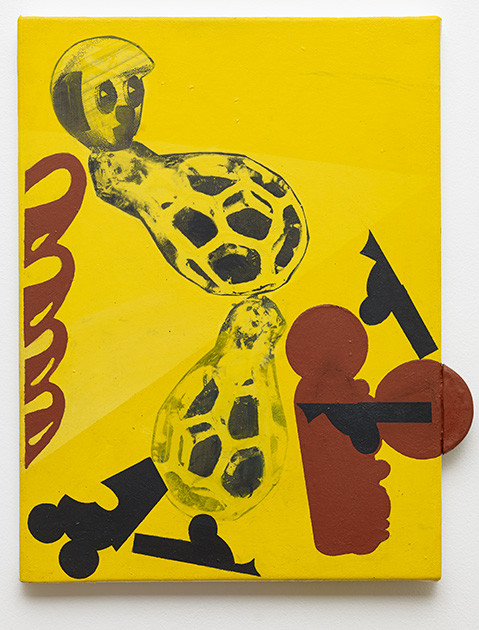JD Williams
11 Sep - 20 Dec 2014

© JD Williams
Breaking News #9, 2011-14 (Detail)
Acrylic, transfer, metal on canvas
9 parts, each: 40,5 x 30,5 cm / 16 x 12,5 in
Breaking News #9, 2011-14 (Detail)
Acrylic, transfer, metal on canvas
9 parts, each: 40,5 x 30,5 cm / 16 x 12,5 in
JD WILLIAMS
Adjust – A
Just – B
11 September - 20 December 2014
The copious practice of JD Williams spans paintings, drawings, sculptures, photography and silk screens. Williams uses repeated variations of a number of specific forms all throughout his work.
Like unshakable obsessions, these shapes recur so persistently, that the work seems to be haunted by their presence, as if an affliction could be lurking in their silhouettes. And yet, these shapes also possess the ability to invoke a wealth of connotations within the viewer; indeed, regardless of their uncanny nature, they feel familiar.
In his paintings, often produced as part of larger series, JD Williams conflates the picture plane with the material surface of the works. As a result, the brightly colored “backgrounds” sometimes evoke vacuums instead, the painted motifs thus appearing to float about in multiple concurrent spaces. The surfaces are in fact thick with multiple layers: of paint, seemingly monochromatic but not quite; of references, like pieces in a puzzle too intricate to only produce one coherent image; and of shapes, the aforementioned recurring motifs, which he refers to as his “tools.”
These so-called tools appear in his works in various forms, both drawn and painted directly on the canvas or as “transfers”, a technique he often employs, where a printed image is glued to the surface and then removed, thereby leaving traces of ink on the canvas. These tools, which include elongated geometric shapes, curved cutouts, a robotic-seeming head, circles placed atop a trapezoid reminiscent of a cartoon figure, and more, have accompanied him for several decades and become integral to Williams’ artistic vocabulary. They originate, like many objects in his work, from found imagery. But while the artist’s original encounter with the image influenced its initial integration into his vocabulary, most tools have in the meantime been rendered richer and more complex in evocative potential, refined and redefined to assume certain standardization, that their origin is only secondary to their almost automated implementation.
More often than not, Williams’ treatment of the various mediums he works with shirks traditional approaches. He soaks photosensitive paper in organic chemicals and rubs the blackened paper against objects to create photographic frottage. He obscures the focus on his digital camera with his fingers, and takes a photo just as he’s quickly removing his hand, so as to capture objects precisely in the seconds it takes the digital camera to adjust its parameters to the light conditions. His drawings and works on paper are sometimes created on scanners and printers, where he interferes with the technology to create disturbances. With slippages, distortions and disturbances, paired with strategies such as repetition, abstraction and modification, JD Williams conceives of a specific visual language all his own, transforming abstractions into codified signs – a personal language capable of universality.
Text: Hili Perlson
Adjust – A
Just – B
11 September - 20 December 2014
The copious practice of JD Williams spans paintings, drawings, sculptures, photography and silk screens. Williams uses repeated variations of a number of specific forms all throughout his work.
Like unshakable obsessions, these shapes recur so persistently, that the work seems to be haunted by their presence, as if an affliction could be lurking in their silhouettes. And yet, these shapes also possess the ability to invoke a wealth of connotations within the viewer; indeed, regardless of their uncanny nature, they feel familiar.
In his paintings, often produced as part of larger series, JD Williams conflates the picture plane with the material surface of the works. As a result, the brightly colored “backgrounds” sometimes evoke vacuums instead, the painted motifs thus appearing to float about in multiple concurrent spaces. The surfaces are in fact thick with multiple layers: of paint, seemingly monochromatic but not quite; of references, like pieces in a puzzle too intricate to only produce one coherent image; and of shapes, the aforementioned recurring motifs, which he refers to as his “tools.”
These so-called tools appear in his works in various forms, both drawn and painted directly on the canvas or as “transfers”, a technique he often employs, where a printed image is glued to the surface and then removed, thereby leaving traces of ink on the canvas. These tools, which include elongated geometric shapes, curved cutouts, a robotic-seeming head, circles placed atop a trapezoid reminiscent of a cartoon figure, and more, have accompanied him for several decades and become integral to Williams’ artistic vocabulary. They originate, like many objects in his work, from found imagery. But while the artist’s original encounter with the image influenced its initial integration into his vocabulary, most tools have in the meantime been rendered richer and more complex in evocative potential, refined and redefined to assume certain standardization, that their origin is only secondary to their almost automated implementation.
More often than not, Williams’ treatment of the various mediums he works with shirks traditional approaches. He soaks photosensitive paper in organic chemicals and rubs the blackened paper against objects to create photographic frottage. He obscures the focus on his digital camera with his fingers, and takes a photo just as he’s quickly removing his hand, so as to capture objects precisely in the seconds it takes the digital camera to adjust its parameters to the light conditions. His drawings and works on paper are sometimes created on scanners and printers, where he interferes with the technology to create disturbances. With slippages, distortions and disturbances, paired with strategies such as repetition, abstraction and modification, JD Williams conceives of a specific visual language all his own, transforming abstractions into codified signs – a personal language capable of universality.
Text: Hili Perlson
